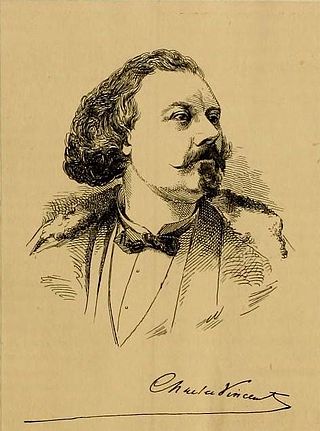
Fetish fashion is any style or appearance in the form of a type of clothing or accessory, created to be extreme, revealing, skimpy, or provocative in a fetishistic manner. These styles are by definition not worn by the majority of people; if everyone wears an item, it cannot have fetishistic, special nature. They are usually made of materials such as leather, latex or synthetic rubber or plastic, nylon, PVC, spandex, fishnet, and stainless steel. Some fetish fashion items include: stiletto heel shoes and boots, hobble skirts, corsets, collars, full-body latex catsuits, stockings, miniskirt, crotchless underwear, jockstraps, diapers, garters, locks, rings, zippers, eyewear, handcuffs, and stylized costumes based on more traditional outfits, such as wedding dresses that are almost completely see-through lace, or lingerie for men.

Prada S.p.A. is an Italian luxury fashion house founded in 1913 in Milan by Mario Prada. It specializes in leather handbags, travel accessories, shoes, ready-to-wear, and other fashion accessories. Prada licenses its name and branding to Luxottica for eyewear and L’Oréal for fragrances and cosmetics.

Thigh-high boots, known also as thigh-length boots or simply thigh boots, are boots that extend above the knees to at least mid-thigh. Other terms for this footwear include over-the-knee boots, a name originally used for 15th century riding boots for men. These are sometimes called pirate boots, especially when cuffed. Over-the-knee boots are sometimes abbreviated to OTK boots. Lengths vary from reaching just over the knee to reaching almost to the crotch.

Chanel is a French luxury fashion house founded in 1910 by Coco Chanel in Paris. It is privately owned by the Wertheimer family and has been headquartered in London since 2018.

Louis Vuitton Malletier, commonly known as Louis Vuitton, is a French luxury fashion house and company founded in 1854 by Louis Vuitton. The label's LV monogram appears on most of its products, ranging from luxury bags and leather goods to ready-to-wear, shoes, perfumes, watches, jewellery, accessories, sunglasses and books. Louis Vuitton is one of the world's leading international fashion houses. It sells its products through standalone boutiques, lease departments in high-end departmental stores, and through the e-commerce section of its website.
Givenchy is a French luxury fashion and perfume house. It hosts the brand of haute couture and ready-to-wear clothing, accessories, perfumes and cosmetics of Parfums Givenchy. The house of Givenchy was founded in 1952 by designer Hubert de Givenchy and is a member of Chambre Syndicale de la Haute Couture et du Prêt-à-Porter. It is currently owned by luxury conglomerate LVMH.

Bally is a Swiss luxury fashion house established in 1851 by Carl Franz Bally and his brother Fritz. Historically known for its shoes, the brand also produces bags, accessories, and ready-to-wear. Rhuigi Villaseñor was its creative director from 2022-2023.
Streetwear is a style of casual clothing which became global in the 1990s. It grew from New York hip hop fashion and Californian surf culture to encompass elements of sportswear, punk, skateboarding, 1980s nostalgia, and Japanese street fashion. Later, haute couture became an influence, and was in turn influenced by streetwear. Streetwear centers on comfortable clothing and accessories such as jeans, T-shirts, baseball caps, and sneakers. Brands may create exclusivity through intentional product scarcity; enthusiasts follow particular brands and try to obtain limited edition releases, including via proxy purchases.

Francisco Rabaneda Cuervo, more commonly known under the pseudonym of Paco Rabanne, was a Spanish fashion designer.

Veja is a French footwear and accessories brand founded in 2004. Veja's products are made with organic cotton and recycled plastic bottles.
Maud Frizon de Marco is a fashion designer specializing in women's shoes. She began her career in the 1960s as a model for Parisian Haute Couture Houses of Nina Ricci, Jean Patou, and André Courrèges. At the time models had to provide their own shoes to match the clothes designers assigned them for their runway shows and photo shoots. Frizon disliked the available shoes from other designers, and in 1969 elected to create her own and opened her first boutique in the Saint-Germain-des-Prés district of Paris.

Charles Jourdan was a French fashion designer known best for his designs of women's shoes starting in 1919. His name reached its greatest reputation in the years since his death under the leadership of his sons, first with an emphasis on the use of innovative materials and later for more conservative designs. After 2000 the company went into decline and was sold to investment bankers.

History of fashion design refers specifically to the development of the purpose and intention behind garments, shoes, accessories, and their design and construction. The modern industry, based around firms or fashion houses run by individual designers, started in the 19th century with Charles Frederick Worth who, beginning in 1858, was the first designer to have his label sewn into the garments he created.

Longchamp is a French leather goods company, founded in Paris in 1948 by Jean Cassegrain. The company pioneered luxury leather-covered pipes before expanding into small leather goods. Longchamp debuted women's handbags in 1971, becoming one of France's leading leather goods makers. Today, the company designs and manufactures leather and canvas handbags, luggage, shoes, travel items, fashion accessories, and women's ready-to-wear. The house is privately owned and managed by the Cassegrain founding family and does business in 80 countries through around 1,500 retail outlets.

PVC clothing is shiny clothing made from the plastic polyvinyl chloride (PVC). PVC plastic is often called "vinyl" and this type of clothing is commonly known as "vinyl clothing". PVC is sometimes confused with the similarly shiny patent leather.
Sarenza is a French e-commerce company that specializes in selling shoes and accessories. Founded in September 2005, the company has its headquarters in Paris and delivers products to 26 European countries. As of 2014, Sarenza had more than 200 employees and carried a variety of brands and styles. The company has expanded throughout Europe since 2009.
Grendene is a Brazilian company that is the world's largest manufacturer of sandals. It was founded by Alexandre Grendene Bartelle and his twin brother Pedro Grendene Bartelle.
Romain Kremer is a French fashion designer. He graduated from the Duperré School of Decorative Arts in Paris in 2002, and the following year he went to work for firms like Christian Dior Monsieur.

Pataugas is a French shoe brand, headquartered in Aix-en-Provence. The company was founded in 1950 to market the Pataugas work and hiking shoe, and has since expanded to offer a range of hiking and leisure footwear. In 2023 the brand was acquired by VGM Holding, who announced that they would not be retaining the employees or the company's stores.

Charles Hubert Vincent was a 19th-century French playwright, chansonnier, goguettier, novelist, journalist and publisher.















